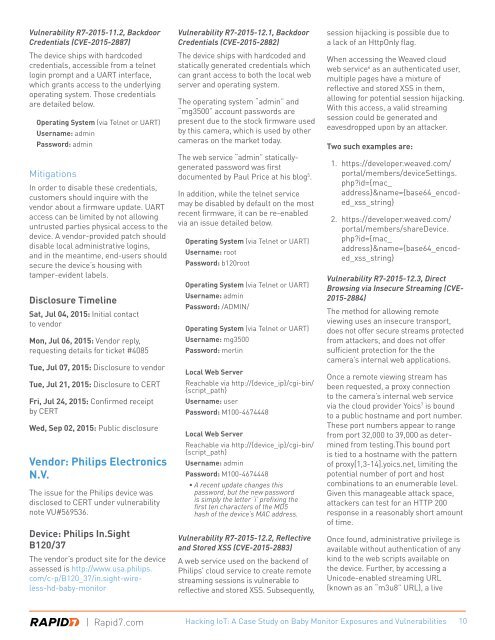HACKING IoT A Case Study on Baby Monitor Exposures and Vulnerabilities
RL2Fq
RL2Fq
You also want an ePaper? Increase the reach of your titles
YUMPU automatically turns print PDFs into web optimized ePapers that Google loves.
Vulnerability R7-2015-11.2, Backdoor<br />
Credentials (CVE-2015-2887)<br />
The device ships with hardcoded<br />
credentials, accessible from a telnet<br />
login prompt <strong>and</strong> a UART interface,<br />
which grants access to the underlying<br />
operating system. Those credentials<br />
are detailed below.<br />
Operating System (via Telnet or UART)<br />
Username: admin<br />
Password: admin<br />
Mitigati<strong>on</strong>s<br />
In order to disable these credentials,<br />
customers should inquire with the<br />
vendor about a firmware update. UART<br />
access can be limited by not allowing<br />
untrusted parties physical access to the<br />
device. A vendor-provided patch should<br />
disable local administrative logins,<br />
<strong>and</strong> in the meantime, end-users should<br />
secure the device’s housing with<br />
tamper-evident labels.<br />
Disclosure Timeline<br />
Sat, Jul 04, 2015: Initial c<strong>on</strong>tact<br />
to vendor<br />
M<strong>on</strong>, Jul 06, 2015: Vendor reply,<br />
requesting details for ticket #4085<br />
Tue, Jul 07, 2015: Disclosure to vendor<br />
Tue, Jul 21, 2015: Disclosure to CERT<br />
Fri, Jul 24, 2015: C<strong>on</strong>firmed receipt<br />
by CERT<br />
Wed, Sep 02, 2015: Public disclosure<br />
Vendor: Philips Electr<strong>on</strong>ics<br />
N.V.<br />
The issue for the Philips device was<br />
disclosed to CERT under vulnerability<br />
note VU#569536.<br />
Device: Philips In.Sight<br />
B120/37<br />
The vendor’s product site for the device<br />
assessed is http://www.usa.philips.<br />
com/c-p/B120_37/in.sight-wireless-hd-baby-m<strong>on</strong>itor<br />
Vulnerability R7-2015-12.1, Backdoor<br />
Credentials (CVE-2015-2882)<br />
The device ships with hardcoded <strong>and</strong><br />
statically generated credentials which<br />
can grant access to both the local web<br />
server <strong>and</strong> operating system.<br />
The operating system “admin” <strong>and</strong><br />
“mg3500” account passwords are<br />
present due to the stock firmware used<br />
by this camera, which is used by other<br />
cameras <strong>on</strong> the market today.<br />
The web service “admin” staticallygenerated<br />
password was first<br />
documented by Paul Price at his blog 5 .<br />
In additi<strong>on</strong>, while the telnet service<br />
may be disabled by default <strong>on</strong> the most<br />
recent firmware, it can be re-enabled<br />
via an issue detailed below.<br />
Operating System (via Telnet or UART)<br />
Username: root<br />
Password: b120root<br />
Operating System (via Telnet or UART)<br />
Username: admin<br />
Password: /ADMIN/<br />
Operating System (via Telnet or UART)<br />
Username: mg3500<br />
Password: merlin<br />
Local Web Server<br />
Reachable via http://{device_ip}/cgi-bin/<br />
{script_path}<br />
Username: user<br />
Password: M100-4674448<br />
Local Web Server<br />
Reachable via http://{device_ip}/cgi-bin/<br />
{script_path}<br />
Username: admin<br />
Password: M100-4674448<br />
• A recent update changes this<br />
password, but the new password<br />
is simply the letter ‘i’ prefixing the<br />
first ten characters of the MD5<br />
hash of the device’s MAC address.<br />
Vulnerability R7-2015-12.2, Reflective<br />
<strong>and</strong> Stored XSS (CVE-2015-2883)<br />
A web service used <strong>on</strong> the backend of<br />
Philips’ cloud service to create remote<br />
streaming sessi<strong>on</strong>s is vulnerable to<br />
reflective <strong>and</strong> stored XSS. Subsequently,<br />
sessi<strong>on</strong> hijacking is possible due to<br />
a lack of an HttpOnly flag.<br />
When accessing the Weaved cloud<br />
web service 6 as an authenticated user,<br />
multiple pages have a mixture of<br />
reflective <strong>and</strong> stored XSS in them,<br />
allowing for potential sessi<strong>on</strong> hijacking.<br />
With this access, a valid streaming<br />
sessi<strong>on</strong> could be generated <strong>and</strong><br />
eavesdropped up<strong>on</strong> by an attacker.<br />
Two such examples are:<br />
1. https://developer.weaved.com/<br />
portal/members/deviceSettings.<br />
php?id={mac_<br />
address}&name={base64_encoded_xss_string}<br />
2. https://developer.weaved.com/<br />
portal/members/shareDevice.<br />
php?id={mac_<br />
address}&name={base64_encoded_xss_string}<br />
Vulnerability R7-2015-12.3, Direct<br />
Browsing via Insecure Streaming (CVE-<br />
2015-2884)<br />
The method for allowing remote<br />
viewing uses an insecure transport,<br />
does not offer secure streams protected<br />
from attackers, <strong>and</strong> does not offer<br />
sufficient protecti<strong>on</strong> for the the<br />
camera’s internal web applicati<strong>on</strong>s.<br />
Once a remote viewing stream has<br />
been requested, a proxy c<strong>on</strong>necti<strong>on</strong><br />
to the camera’s internal web service<br />
via the cloud provider Yoics 7 is bound<br />
to a public hostname <strong>and</strong> port number.<br />
These port numbers appear to range<br />
from port 32,000 to 39,000 as determined<br />
from testing.This bound port<br />
is tied to a hostname with the pattern<br />
of proxy[1,3-14].yoics.net, limiting the<br />
potential number of port <strong>and</strong> host<br />
combinati<strong>on</strong>s to an enumerable level.<br />
Given this manageable attack space,<br />
attackers can test for an HTTP 200<br />
resp<strong>on</strong>se in a reas<strong>on</strong>ably short amount<br />
of time.<br />
Once found, administrative privilege is<br />
available without authenticati<strong>on</strong> of any<br />
kind to the web scripts available <strong>on</strong><br />
the device. Further, by accessing a<br />
Unicode-enabled streaming URL<br />
(known as an “m3u8” URL), a live<br />
| Rapid7.com Hacking <str<strong>on</strong>g>IoT</str<strong>on</strong>g>: A <str<strong>on</strong>g>Case</str<strong>on</strong>g> <str<strong>on</strong>g>Study</str<strong>on</strong>g> <strong>on</strong> <strong>Baby</strong> M<strong>on</strong>itor <strong>Exposures</strong> <strong>and</strong> <strong>Vulnerabilities</strong> 10


